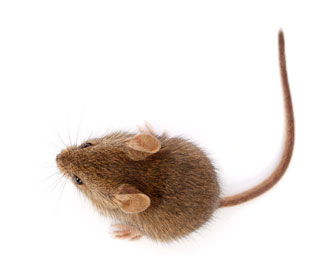How to Check for Mice in Your House
By Chris Williams on March 5, 2014.
 So, you’re worried that you have mice? You can begin by calling a pest management professional for a full inspection of your home. Or, if you’re one of those die-hard do-it-yourselfers, you can do some preliminary checking on your own.
So, you’re worried that you have mice? You can begin by calling a pest management professional for a full inspection of your home. Or, if you’re one of those die-hard do-it-yourselfers, you can do some preliminary checking on your own.
Where to Look for Mice
(1) Nests
Female mice collect any kind of soft material that they can find to line their nests like shredded paper, string, tissues, cloth, or insulation. [See “Mice Will Shred Fabrics for Nest Material”] The nest itself is a loose wad of these materials, about the size of a softball. There’s a lot of variability. Some nests are more or less spherical, some are just flattened, messy mats. Nests might also contain bits of hoarded seeds or other food.
Look for nests at ground level, in hidden corners, in sites that are not too far from a food source. Mice usually nest within 30 feet of where they are finding food. A food source is pretty much your kitchen, in general, since there are always some crumbs in the pantry or food spills under the stove or refrigerator. Other mouse food sources are wherever you store dry pet food or bird seed, or where you feed your pet, maybe where your kids eat potato chips.
Typical mouse nest sites in a home are in back corners of lower kitchen cabinets (especially cabinets rarely opened or the cabinet under the sink), in the space behind kick plates at the bottoms of cabinets, inside stove pan drawers, in any box or bin on the floor of a pantry. Mice will nest in closets, attics, garages and basements in stored boxes, bags, or drawers. Mice will nest where they find warmth and soft nest material, such as in insulation inside stoves or refrigerators, the stuffing in an old chair, in a bag of rags, or in a box of old newspapers.
(2) Droppings
Mouse droppings or mouse poop is probably the most abundant sign of mice and the easiest to find. Droppings are similar in size and shape to a grain of rice, except they are black and more pointed at the ends. The only things that would look similar are droppings from a large cockroach like the American cockroach which is usually not found in homes. You can also test whether the droppings break apart. Older droppings are brittle and can be crumbled (you might find pieces of seeds or insects inside); fresh droppings have a softer, putty-like texture. Fresh droppings mean you have a current, active mouse infestation.
Look for droppings wherever a mouse feeds or along its travel route between food and its nest. Mice don’t poop in any one spot; they leave droppings randomly as they travel but usually leave several in any one place, up to a total of about 70 per day. Mice like to travel along edges, for example following along baseboards. You’ll need to pull items out of your lower cabinets. Use a flashlight to check back corners and edges of the cabinet for droppings. If you find spilled food, or you find a nest, you will usually find droppings nearby. Slide a yardstick or a broom under the stove and refrigerator to see if you pull out droppings.
(3) Gnaw Marks
Mice are notorious for chewing openings to gain access to nest sites or to reach food. You might find that mice have enlarged spaces around pipes or holes that cables travel through so that they can squeeze into that space. Recent gnawing on wood will look fresh and will be lighter in color, like newly cut wood. You might even find wood chips nearby. As mice use that opening, passing through it repeatedly, the oils in their fur darken the wood, eventually leaving dark smears around the opening.
Look for gnaw marks in corners or where pipes or lines run through walls, a typical place is around pipe openings under the kitchen sink. Mice will chew a small opening at any edge that opens into a void, or at the corner of a door or so that they can squeeze through when the door is closed. Mice can easily chew into the bottom corners of food boxes and bags. [See “Yes, Mice Gnaw Holes!”]
If you find any of the above evidence of mice, it’s time to consider calling a pest management professional. If you find lots of the above evidence, it’s definitely time to take off your DIY hat and call a pest management professional. Not only are we experts at finding mice, we’re experts at getting rid of them, too. Give Colonial a call.